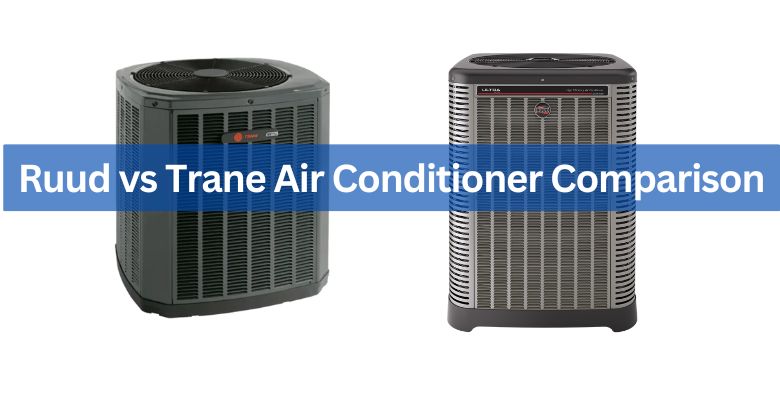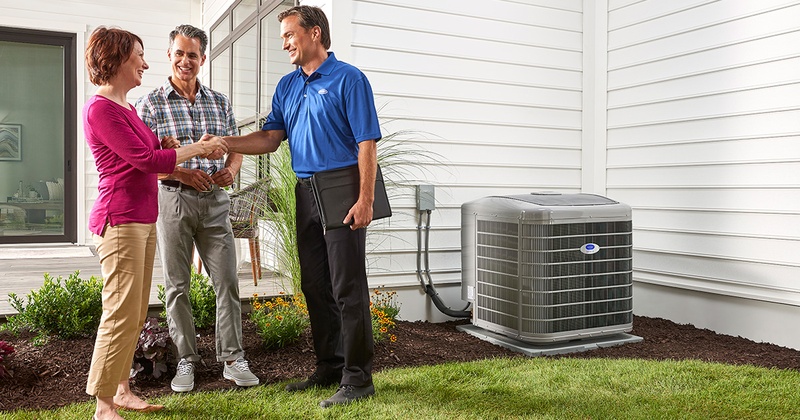
Ruud vs Trane air conditioner is a difficult choice to make by homeowners because both brands are well known yet have different target markets. Trane is commonly regarded as a high-end, premium HVAC brand with quiet operation and heavy build quality, but Ruud (a brand under Rheem) is regarded as a lower-cost, no-frills brand that is still well-built.
This article gives a fair comparison of Ruud and Trane air conditioners on the major dimensions, such as performance, energy efficiency, durability, price, warranty, noise, and user satisfaction to enable you to know the difference between them.
Ruud vs Trane Air Conditioners: Quick Comparison
| Aspect | Ruud Air Conditioners | Trane Air Conditioners |
|---|---|---|
| Energy Efficiency (SEER) | Up to 20.5 SEER on top models (Ultra Series RA20) | Up to 22 SEER on top models (XV20i) |
| Price Range (Installed) | Around $5,170–$13,300 for a typical central AC system | Around $5,500–$17,900 – typically 15–20% higher upfront cost as a premium brand. |
| Warranty | 10-year limited parts warranty. Some models offer 10-year unit replacement if the compressor fails. | 10-year limited parts ; plus up to 12-year compressor or unit replacement coverage on select models. (5-year base warranty if not registered.) |
| Notable Features | Offers two-stage and some variable-speed models (EcoNet™ enabled) for better comfort, though fewer ultra-high-end options. | Uses unique Spine Fin coils for long-term efficiency. Broad lineup including many variable-speed inverter models |
Performance & Cooling Features:
Ruud and Trane air conditioners are both going to reliably cool your home, but there are some design variations that can affect performance, such as the kind of outdoor condenser coil that each brand uses.
The following is a side by side comparison of a typical radiator-fin coil (left) and Trane Spine Fin coil (right). The Spine Fin coil has numerous small aluminum fins attached to its refrigerant tubing, which has a lot more surface area to transfer heat. This design contributes to increased cooling efficiency and assists Trane unit to perform over time.
Both brands have more advanced compressor technology in their upper-end models, although Trane has been more likely to be on the forefront of this technology. The flagship ACs of Trane (such as the XV18 and XV20i) have inverter-driven variable-speed compressors which can vary in hundreds of stages to provide very fine control of temperature.
The high-end Ultra series (e.g. RA20) of Ruud also has a variable-speed compressor, although in the past Ruud (and its sister brand Rheem) had fewer variable models and used more two-stage designs. This implies that Trane offers a wider range of ultra-high-performance units. When you want extreme efficiency or the most comfortable smoothness, Trane 18-22 SEER variable-speed models are currently ahead of the game, providing consistent cooling with little temperature variation.
In the case of normal 14-16 SEER systems, however, Ruud and Trane should work equally well as long as they are installed correctly. The disparities are actually noticeable in the upper end of the product line. To conclude, both brands are very good at cooling, however, Trane has the most advanced models that have a bit smoother and more advanced cooling, whereas Ruud is more practical and reliable and has a good cost-to-performance ratio.
Energy Efficiency:
Both Ruud and Trane manufacture air conditioners that are efficient, however, Trane has a few more efficient models. Ruud tops out at about 20 SEER in its most efficient model and the majority of its products are in the mid-efficiency range of 14-17 SEER. It is economical enough to suit the needs of most homeowners and is up to all the modern standards (many Ruud units are ENERGY STAR 84 certification).On the high end, Trane provides units with up to 22 SEER, which provides it with a minor advantage in the highest efficiency. The majority of the Trane models cover approximately 14.5 SEER to 20+ SEER. Practically, it implies that Trane has several highly efficient models that can possibly save a little more electricity in a hot summer.
Don’t Overpay for HVAC Services – Call 888-894-0154 Now to Compare Local Quotes!
A Ruud and Trane with identical SEER ratings will consume very close amounts of energy in everyday application. The actual benefit is when you choose the most expensive variable-speed systems offered by Trane that may save additional energy during a long cooling season (in extremely hot climates) due to the capacity to adjust output and operate at lower speeds.The special coil design of Trane can also assist in keeping efficiency over the years with less performance loss to dirt or wear. Nevertheless, the efficient models of Ruud are not much behind; they are efficient according to the federal standards and provide a great performance at the price. The point is that Trane has a slight edge in efficiency at the highest level, yet both brands have high-efficiency options that can make your energy bills low. Ruud is likely to provide those savings at a cheaper initial cost, whereas Trane could squeeze a little more efficiency out of you, should you pay more on their high-end models.
Durability and Reliability:
Ruud air conditioners are well known to be long lasting and reliable considering that they are cheaper. They employ tested, widely applied parts such as Copeland ScrollTM compressor, which is reliable in the market. The general construction of a Ruud unit (steel cabinet, copper/aluminum coils, etc.) is that of industry standards and enjoys the manufacturing quality of Rheem.
A Ruud AC system has an average life of about 15-20 years with proper maintenance. Ruud has received high marks in many quarters among HVAC professionals, who cite the reliability and solid, no-nonsense construction of its products, which can last decades with proper maintenance.
The design of the outdoor AC units by Ruud is simple and pragmatic with the emphasis on durability and functionality. The units are made of durable metal cabinets and have accessible parts, and they are more concerned with performance than flashy looks. Trane is usually regarded as a notch higher in terms of general construction, designed to provide a longer service life. Trane is always among the top in HVAC reliability, and it has less repair calls during the first 5-10 years than most other brands.
Both brands produce long-lasting equipment, yet Trane units are designed to possibly last a little longer and withstand a lot of use without many problems. Ruud also provides a long life, which is usually equal to that of more expensive models, but Trane has an additional engineering and quality control that may provide it with a small advantage in terms of life and durability.
Conversely, in case of repairs after several years, the fact that Ruud uses common parts may make repairs less costly, but Trane parts may be more costly to repair. In general, both Ruud and Trane AC will be able to serve you long-term, but Trane will be preferred by those who are interested in the maximum lifespan.
How Do Ruud vs Trane Air Conditioner Costs Compare?
The price is one of the greatest distinctions between Ruud and Trane. Ruud is more affordable in general. An average Ruud central AC system could be installed at a price of about 5000 to 16000 dollars(equipment and installation), depending on the size and efficiency of the system. Trane is a high-end brand, and it tends to be high-end priced, about 15-20 percent more expensive than a comparable capacity or efficiency system in most situations.
As an illustration, an installation of Trane may cost approximately 5,500 to 17,900 dollars in most houses.
The increased initial price of Trane can be partially explained by the fact that the brand is positioned as a high-end HVAC solution with a high level of features. You are paying the name, the usually more complicated technology and the close dealer network. Ruud, in its turn, is aimed at providing the same performance at a lower price, which is quite attractive in case you are on a smaller budget.
Warranty:
Both Ruud and Trane support their air conditioners with a powerful warranty, which is rather similar in both brands. Most Ruud AC units have a 10-year limited warranty on parts (including the compressor and coils) provided that you register the product once it has been installed. The best models of Ruud also tend to have a conditional 10-year unit replacement warranty, i.e. in case the compressor dies within the first 10 years, they will replace the whole condensing unit.
Ruud also offers the possibility to buy an extended protection plan (Protection Plus 12) to cover labor and to extend the coverage to 10 years more than the normal time.
Trane is nearly identical in paper: a 10-year limited parts warranty with registration, the compressor, coil, and internal parts. Failure to register means that the base warranty is 5 years. Trane does extend a little further on some of the higher-end models to provide 12-year coverage on the compressor (or a 12-year whole-unit replacement warranty), which is slightly better than the 10-year unit replacement terms offered by Ruud.Similar to Ruud, Trane provides optional extended warranties (usually by the installer or a third party) that may include labor and more years.
Customer Satisfaction and Reviews: What Do Homeowners Say?

Based on customer reviews and independent ratings, Ruud and Trane receive high ratings in customer satisfaction. Trane usually ranks high in surveys of homeowners due to its reliability, e.g. it has been determined to have fewer issues during the first years of ownership than most other brands. The quiet operation and reliability of cooling are some of the features that many Trane owners point out.
Ruud (and its parent brand Rheem) do not do too bad in satisfaction either; they are commonly ranked high in reliability and performance. It means that both brands are considered reliable options by homeowners and professionals on a large scale.
The customers of Trane tend to feel that they received a better product (and they point out that the high price was worth it), but the customers of Ruud tend to feel that they received good performance at a lower price. The lesson here is that Ruud and Trane enjoy a huge number of satisfied homeowners.
The key to the best result is selecting a quality installer and maintaining it; these are the two things that will guarantee you the full reliability that Ruud and Trane are capable of providing.
How to Get the Best HVAC Prices
- Firstly, keep in mind that installation quality is always the most important thing for residential HVAC project. So never sacrifice contractor quality for a lower price.
- Secondly, remember to look up the latest rebates as we talked above.
- Thirdly, ask for at least 3 bids before you make the decision. You can click here to get 3 free estimates from your local contractors, and this estimate already takes rebates and tax credit into consideration and filter unqualified contractors automatically.
Lastly, once you chose the right contractor, remember to use the tactics from this guide: Homeowners Tactics When Negotiating with HVAC Dealer to get the final best price.



